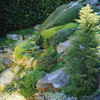Knowing Your Property Landscape
Before You Hire A Landscape Designer...

Type of Project
Knowing what kind of landscape project you have in mind can help your landscape designer give you a more accurate estimate.
For example, when a house is first built, the builder digs a hole and constructs the foundation. When the house is done, he fills in the hole around the foundation. Even if he tamps the earth down, he won't be able to pack as much dirt into the remaining space as he took out.
The builder probably sold a home with perfectly acceptable grading, but over the years the disturbed soil settles back to its original density. As it settles, the slope starts tilting toward the house. Even patios and driveways can be affected. After twenty or thirty years, it is often necessary to re-landscape the yard and, in many cases, replace patios and driveways.
Topography
Knowing your property's topography will help the landscape designer with ideas for your project as well as to get an idea of the amount of labor involved and the type(s) of plants, trees or installations you may want to include.
Landscaping is more than trees, shrubs, and flowers. It also includes the other special features that give your yard a personal touch.
Here are some ideas to spark your imagination:
- Water features such as fountains, waterfalls or pond are very popular. Some can be designed to withstand colder climates
- Lighting systems are both practical and creative. Lights within the yard are a great security element, and they give your home a distinctive look at night.
- Xeriscape is a type of landscaping that uses heartier, low-water plants. This doesn't mean dry thistle and cactus. Xeriscape plants come in a wide variety of attractive shrubs and flowers and are ideal for the environmentally conscious homeowner.
- Decks and trellises are a nice way to create an outdoor room in your yard. Ideal for backyard cookouts and quiet Sunday mornings.
- Berms and retaining walls give your yard a rolling, landscaped look. Berms sometimes look like mounds of dirt. However these elevated planting areas can give an otherwise flat area some variety. Flowers and trees do great in berms, and they also can act as a subtle barrier along the street to keep people off the yard. Retaining walls create man-made elevated planting areas. They are ideal for yards that have a lot of change in elevation. Instead of a steep diagonal slope, you can have a series of planting areas that look like steps.
-- Tips courtesy of HomeAdvisor.com